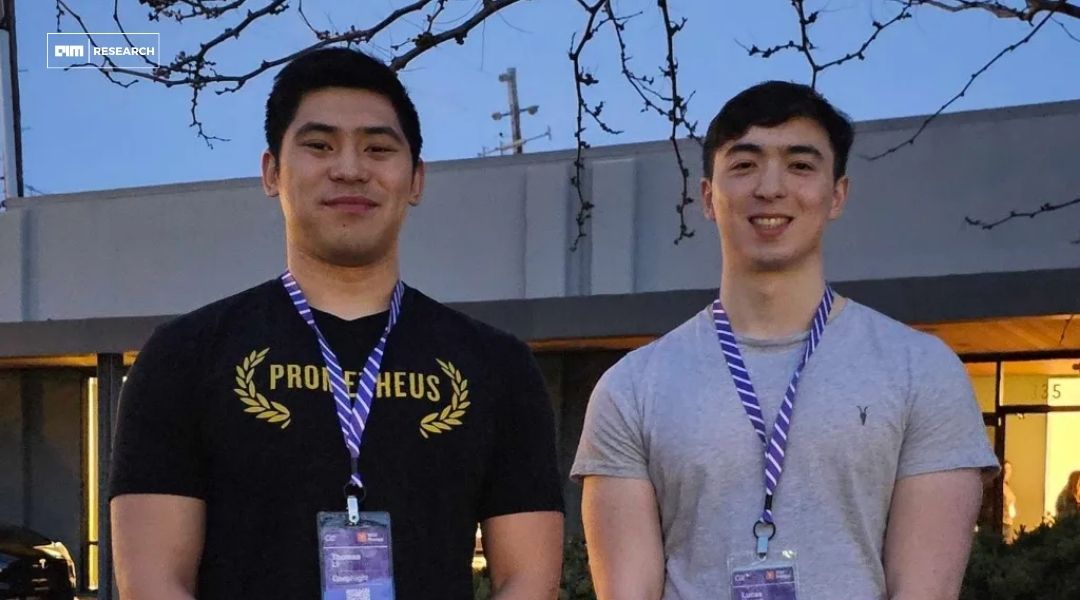
Tech Duo Stunned the Military With AI Night Vision That Beat $30,000 Goggles
- By Anshika Mathews
- Published on
Now we can make everything in the world see in the dark, because it’s just a software program.


For decades, night vision technology has remained largely unchanged, relying on expensive, analog systems that cost anywhere from $13,000 to $30,000 per unit. Despite ongoing efforts by the U.S. military to transition to digital alternatives, night vision remains a hardware problem, with defense contractors like L3Harris and Elbit America continuing to dominate the market with costly, legacy technology. However, a new approach—one that treats night vision as a software problem rather than a hardware one—may finally be shifting the landscape.
Deepnight, a startup founded by childhood friends Lucas Young and Thomas Li, is attempting to redefine digital night vision by leveraging AI and mass-produced smartphone cameras rather than proprietary military hardware. Both former software engineers at Google, Young and Li had spent years working on computational photography and computer vision, respectively. Young, who studied computational photography at Cal Poly, had experience developing software to compensate for the limitations of small smartphone cameras. Li, meanwhile, had a strong background in AI-driven image processing. Their combined expertise positioned them well to tackle the long-standing challenge of digital night vision.
The inspiration for Deepnight came from a 2018 scientific paper titled Learning to See in the Dark, co-authored by AI researcher Vladlen Koltun, now at Apple. The paper explored the potential of AI to enhance low-light imaging, but at the time, hardware limitations prevented real-time implementation. By 2024, Young realized that AI accelerators in modern system-on-chips (SoCs) had improved to the point where real-time, 90-frames-per-second (fps) night vision processing was feasible. Recognizing the opportunity, Young convinced Li to leave Google, and together they founded Deepnight. They were quickly accepted into Y Combinator’s winter cohort.
While the military was an obvious customer for their technology, Young and Li had no direct way to pitch the Pentagon. Instead, Young attended an industry event where members of the U.S. Army’s night vision laboratory, formally known as the C5ISR Center, were present. He distributed copies of a white paper outlining their software-based approach. One of those papers landed in the hands of an army colonel who, intrigued by the idea, connected them with the right people at the lab.
Desperate to prove their concept, the duo quickly built a rudimentary prototype: a night vision smartphone app combined with a VR headset to mimic the experience of traditional goggles. While simple, the demo was effective. In February 2024, just a month into Y Combinator, the Army awarded them a $100,000 contract based solely on their smartphone-based proof of concept and white paper.
Deepnight’s progress didn’t stop there. They soon had to present a more formal demonstration in Washington, D.C., to a room of military officials. Their AI-driven software went head-to-head with state-of-the-art military goggles. The demo was convincing enough to secure additional contracts, and within a year of launching, Deepnight had booked around $4.6 million in government contracts from the U.S. Army and Air Force, as well as partnerships with companies like Sionyx and SRI International.
Credits: Deepnight
Deepnight’s success quickly caught the attention of investors. By the end of Y Combinator, the startup raised a $5.5 million funding round led by Initialized Capital. Notable angel investors included former In-Q-Tel partner Brian Shin, entrepreneur Kulveer Taggar, and Matthew Bellamy, lead singer of Muse. Perhaps the most meaningful endorsement came from Vladlen Koltun himself, whose research had originally inspired the company—he too became an investor.
Unlike traditional night vision companies that develop proprietary goggles and optics, Deepnight provides software that can be integrated into a variety of hardware platforms. This flexibility allows it to work with off-the-shelf $50 smartphone cameras rather than expensive, custom-built military-grade sensors. The company is now partnering with manufacturers of goggles, military helmets, and other hardware to incorporate its AI-driven imaging technology.
While the military remains a key customer, Deepnight’s technology has applications far beyond defense. Their software can be integrated into drones, automotive night vision systems, security cameras, maritime navigation, and disaster response tools. With AI-enhanced imaging, even standard CMOS sensors found in everyday smartphones, can produce high-quality images in near-total darkness, making night vision accessible to a wide range of industries.
The shift from analog to digital night vision has been slow, largely due to the dominance of legacy defense contractors and the high cost of traditional systems. Deepnight’s rapid success suggests that a software-first approach may finally accelerate this transition. In less than a year, the company has not only secured millions in government contracts but has also demonstrated that AI-driven night vision can outperform existing military-grade goggles at a fraction of the cost.
As Young describes it, “Now we can make everything in the world see in the dark, because it’s just a software program. So that’s automotive, security, drones, maritime like boats, electronics, nav cameras.”
📣 Want to advertise in AIM Research? Book here >
Cypher 2024
21-22 Nov 2024, Santa Clara Convention Center, CA
A Vendor Briefing is a research tool for our industry analysts, and an opportunity for a vendor to present its products, services and business strategies to analysts who cover the vendor specifically or a related technology or market.
AIM Research encourages technology vendors and agencies to brief our team for PeMa Quadrants, when introducing a new product, changing a business model, or forming a partnership, merger, or acquisition.


